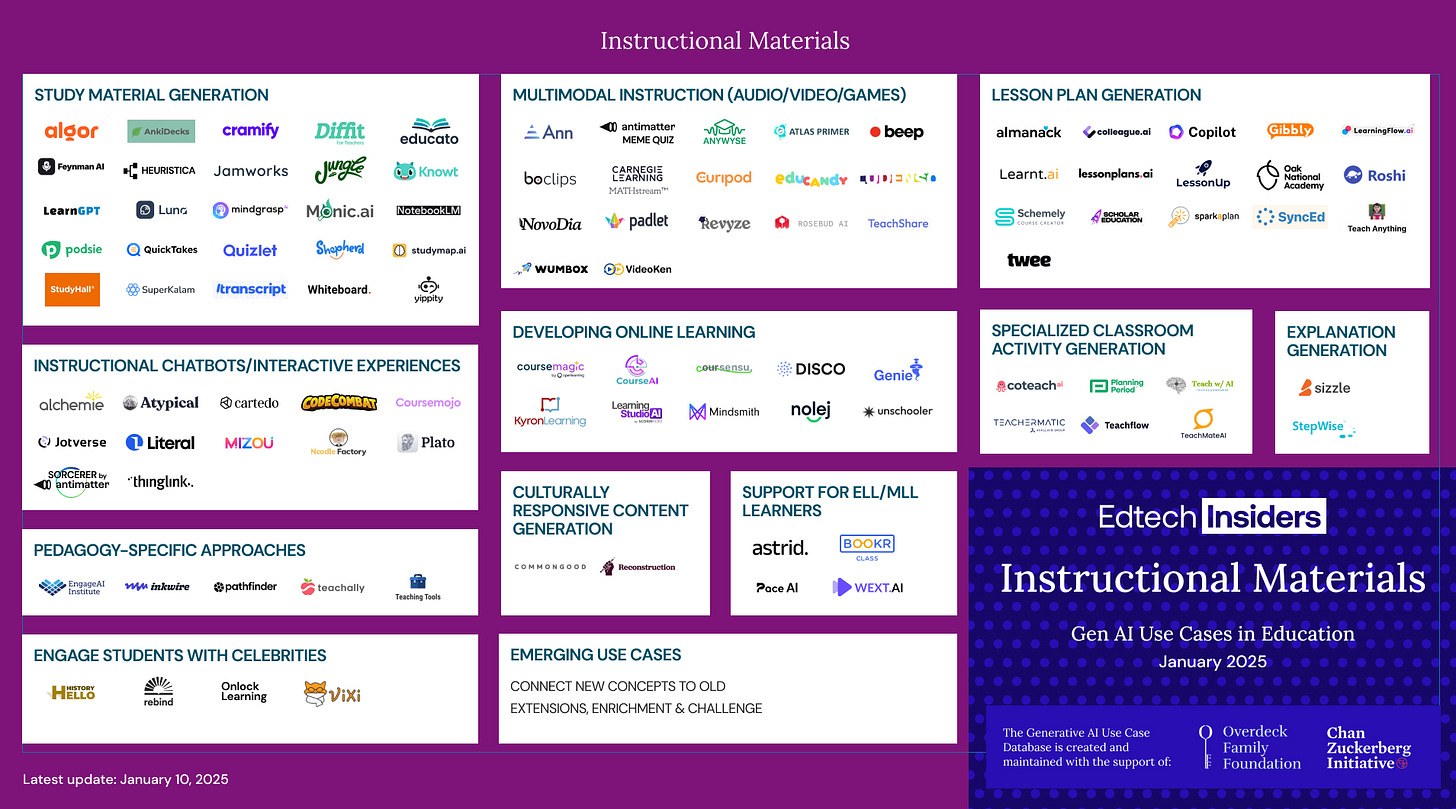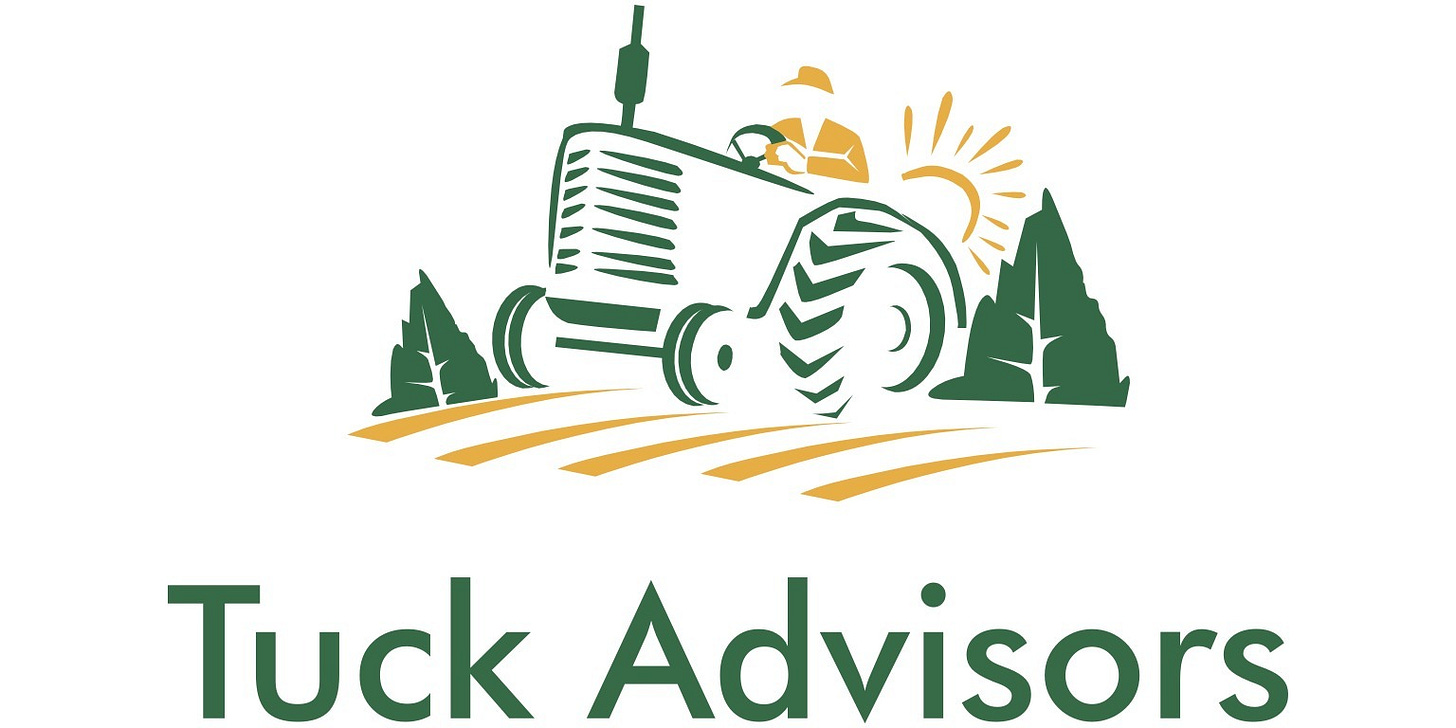From Theory to Practice: How Generative AI is Redefining Instructional Materials
Top trends and insights from The Edtech Insiders Generative AI Map research process about how Generative AI is transforming Instructional Materials
From Theory to Practice: How Generative AI is Redefining Instructional Materials
By Alex Sarlin
As part of our updates to the Edtech Insiders Generative AI Map, we’re excited to release a new mini market map and article deep dive on Generative AI tools that are specifically designed for Instructional Materials use cases.
In our database, the Instructional Materials use case category encompasses tools that:
Assist educators by streamlining lesson planning, curriculum development, and content customization
Enable educators or students to transform materials into alternative formats, such as videos, podcasts, or other interactive media, in addition to leveraging gaming principles or immersive VR to enhance engagement
Empower educators or students to transform text, video, slides or other source material into study aids like study guides, flashcards, practice tests, or graphic organizers
Engage students through interactive lessons featuring historical figures, authors, or fictional characters
Customize curriculum to individual needs or pedagogical approaches
Empower educators or students to quickly create online learning assets and courses
Gen AI Trends for Instructional Materials
While we can’t encapsulate everything that is included in the rapidly evolving landscape of Gen AI and Instructional Materials, here are some of the top trends and insights we compiled while completing our most up to date research for The Edtech Insiders Gen AI Map:
Evolving Intelligent Content Creation
Educational content creation is transforming on a fundamental level, shifting from traditional textbooks to AI-enabled adaptive materials. These new systems, which are highly customizable and responsive to individual student needs, are being developed with deep insights from cognitive science and learning theory. AI algorithms can integrate learning principles like cognitive load theory and the spacing effect, automatically adjusting content complexity and review intervals based on how students engage.
This shift not only advances evidence-based instructional design but also changes the role of educators. Teachers are moving away from adapting static materials and towards becoming strategic instructional architects. They use adaptive systems to guide their teaching strategies while focusing on the interpersonal and motivational aspects of education. This evolution suggests a future where technology enhances rather than replaces human instruction, posing important implications for professional development and teacher training.
Shifting Economics of Rich Media Production
The economics of educational content creation are undergoing a major transformation, democratizing access to high-quality instructional materials. Traditionally, producing engaging educational media like simulations, games, VR experiences, or educational music was extremely costly, often requiring hundreds of thousands of dollars for a single interactive module. Now, AI is drastically reducing these costs through automated content generation, intelligent asset creation, and streamlined production processes, lowering development expenses significantly. This shift isn’t just improving efficiency marginally; it’s a revolutionary change making high-engagement content more affordable and accessible than ever before.
For a look at what’s possible, consider AI tools like Suno, which, with lyrical input from Claude, can generate on-demand music about educational topics. For example, Alex created a playlist about Early American Wars in various modern styles in under an hour.
French-Indian War: 1754! (Oh Baby, That's The War).mp3
War of 1812: good nation, m.A.A.d Britain.mp3
Black Hawk War: BLACK HAWK DOWN IN ILLINOIS .mp3
Great Sioux War: sacred ground_(they knew all along).mp3
If the concept of multimodal educational content leaves you cold, consider the broader implications of this economic shift. We're seeing the rise of "pedagogical scalability" — the capability to develop sophisticated learning experiences using evidence-based practices at a much lower cost. Content that was previously exclusive to premium private schools or well-funded pilot programs is now becoming more widely available. For example, interactive physics simulations adapt to student misconceptions, language learning games optimize vocabulary review timing, and chemistry labs include integrated video support, all transforming from high-cost luxuries to standard educational tools. AI systems are not just duplicating content but are increasingly capable of applying educational principles systematically across various subjects and contexts.
This democratization of high-end content is especially apparent in adaptive assessment and practice. Where traditional publishers once charged heavily for adaptive features, AI now makes advanced adaptation standard. Modern systems can generate endless variations of practice problems tailored to each student’s needs, optimize for long-term retention, and create engaging, data-rich narrative scenarios. These advancements are reducing costs significantly, making such tools accessible for widespread use, not just in affluent areas or exclusive products. This shift is subtly yet profoundly transforming classroom possibilities and raises questions about the future roles of traditional educational publishers and creators in a rapidly changing landscape—might Google's on-demand educational videos via YouTube challenge traditional Edtech video libraries entirely?
Democratizing Content Across Stakeholders
The democratization of educational content is happening through three interconnected layers, each revolutionizing how learning materials are tailored and delivered to students. At the highest level, publishers and edtech companies are using AI to craft smarter base content that not only meets educational needs but also adapts to how students learn. These systems monitor engagement, learning progress, and retention, constantly fine-tuning their methods.
In the middle layer, teachers play a pivotal role. Historically, they've been creators, curators, and modifiers of content. Now, AI tools enhance these roles, allowing teachers to customize materials without losing the integrity of the underlying educational principles. For instance, a history teacher might convert a text-heavy lesson into a multimedia presentation, confident that the AI will preserve the sequence of concepts and comprehension checks.
The bottom layer involves student customization, where the change is most striking. Students now have more control over how they engage with content, able to convert textbook chapters into podcasts, dense texts into interactive flashcards, or lessons into formats akin to their social media experiences. Importantly, AI ensures that these adaptations maintain the educational structure—whether it's through Quizlet-style flashcards, TikTok-like mini-lessons, or comprehensive practice sets, the essential learning elements like spacing, sequencing, and assessment remain intact.
Supporting Learning Preferences and Accessibility
Consider the profound impact of student variability on their engagement with educational content. Each learner brings a unique blend of cognitive needs, cultural contexts, and technological access. Tailored learning approaches significantly benefit groups like neurodivergent students, English Language Learners (ELLs)/Multilingual Learners (MLLs), and those with specific learning disabilities. Ultimately, every student benefits from personalized learning methods regardless of their background.
The necessity for varied learning experiences becomes clear when considering environmental differences alone: A teenager studying on their phone during a noisy bus ride versus the same student working on a laptop in a quiet library illustrates the diverse conditions under which learning occurs. Modern AI-enabled content is particularly adept at meeting these varied needs. It can seamlessly adapt to become a low-bandwidth audio lesson suitable for a noisy environment, an interactive simulation perfect for a serene library setting, or a culturally relevant case study, ensuring that each student finds their learning pathway both engaging and accessible.
Teachers, crucial in this adaptive process, use AI tools to tailor content with precision. They can modify a lesson on photosynthesis for students of varying reading levels, languages, or learning challenges, while keeping the core scientific concepts intact. This adaptation goes beyond traditional accessibility; it makes learning deeply relevant and engaging for each student. Their deep understanding of student needs drives this meaningful transformation.
This approach not only matches traditional educational rigor but also aligns with modern consumption habits. Students might prefer TikTok-style videos or game-like interfaces, and teachers can now meet these preferences without sacrificing educational quality. The learning science embedded in AI tools ensures that whether a student is watching a video or engaging with a simulation, they are still experiencing the essential cognitive elements necessary for deep understanding. This is a prime example of how technology enables an educational approach that says "yes, and" rather than "either/or."
What’s Next: Super-Rich Media and Authentic Learning
The transformative future of educational content — the one that has forward-thinking educators both thrilled and a bit nervous — represents more than just an extension of current trends. It's a fundamental rethinking of what "learning materials" means. While the concept of "the classroom of the future" has often been discussed, we are now at a point where such futuristic visions are within reach.
Imagine AI systems capable of creating entire virtual worlds in response to a student's question — not just simulating photosynthesis, but providing an explorable forest ecosystem where molecular biology and ecological principles intermingle seamlessly. These environments are not the clunky educational games of the past, but rich environments where learning science principles are woven into the very fabric of the experience.
The potential for transforming assessment and skill development is particularly striking. Envision a Spanish language learner navigating a virtual town, populated with contextually-aware NPCs who adapt their speech patterns to the student's fluency. Or picture a budding engineer learning physics by troubleshooting complex machinery in a virtual workshop that mimics reality. This blurring of lines between "studying" and "doing" offers a glimpse into a new paradigm of learning.
These possibilities are not just theoretical but are becoming feasible today. This shift toward immersive, project-based, and active learning promises not only to enhance academic knowledge but to develop durable, career-relevant skills through experiences that mirror real-world professions. The building blocks for this transformation are already here. The only real question is whether our educational institutions are ready for the wild ride ahead.
Edtech Insiders is Sponsored By:
Calling All Education Entrepreneurs! The Milken-Penn GSE Education Business Plan Competition (EBPC) is accepting applications now through February 19, 2025. Compete for over $200,000 in cash and prizes and connect with global education leaders and investors. Since 2010, the competition has awarded $2 million, with winners and finalists securing over $200 million in funding.
The EBPC is the world’s premier competition for early-stage ventures tackling inequities in education through innovation. It's open to education ventures worldwide addressing learning at any level, with less than $2M raised or earned in the past year—no Penn affiliation required!
This edition of the Edtech Insiders Newsletter is sponsored by Tuck Advisors.
Since 2017, Tuck Advisors has been a trusted name in Education M&A. Run by serial entrepreneurs with over 25 years of experience in founding, investing in, and selling companies, we believe you deserve M&A advisors who work as hard as you do. Please enjoy access to The M&A Matrix by Tuck Advisors™ on ChatGPT—tailored to support founders and CEOs like you in navigating the M&A world.
Have questions, or are you ready to explore the next steps? Reach out to us.
Cooley LLP is the go-to law firm for edtech innovators, from early childhood through workforce. Informed by decades of experience in the education vertical, Cooley created the first edtech practice to provide industry-informed, business-minded counsel to companies and organizations at all stages of the corporate lifecycle. Cooley provides a multidisciplinary approach to client needs, offering seamless collaboration across offices and practices.
To learn more about what Cooley can do for you, reach out to Naomi May.







Thanks for sharing
Dear Alex, this is a good article, we like it. I think that the Spanish-speaking community can be also interested. Is it possible we translate part of this post, with credits and links to your newsletter and to you? Many thanks in advance.